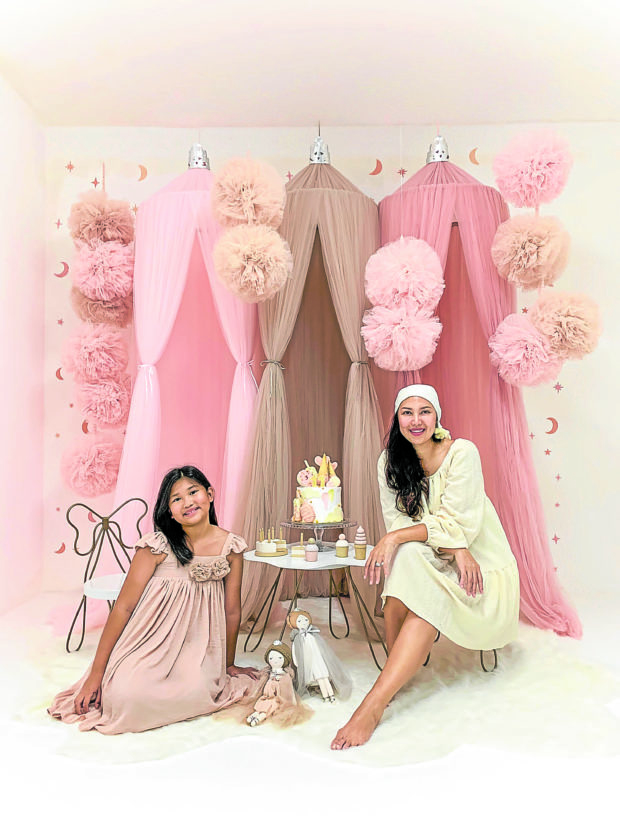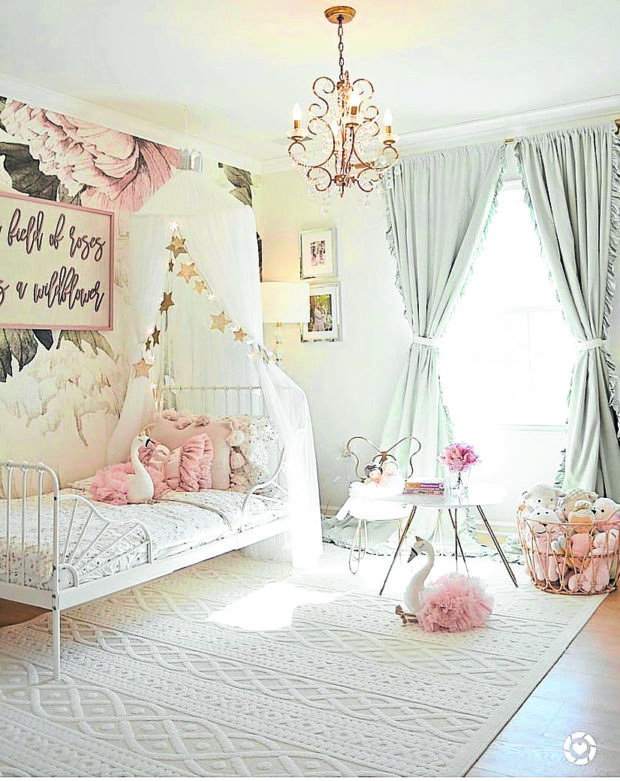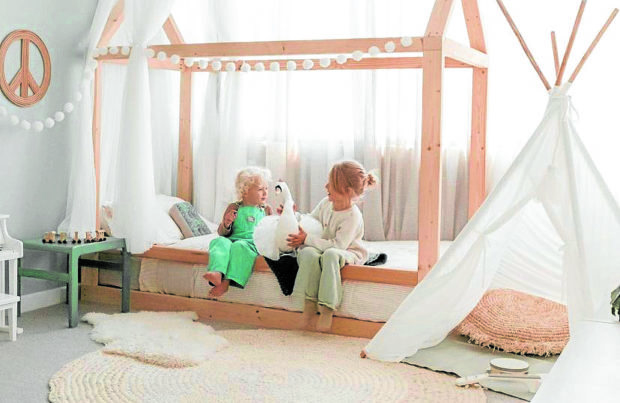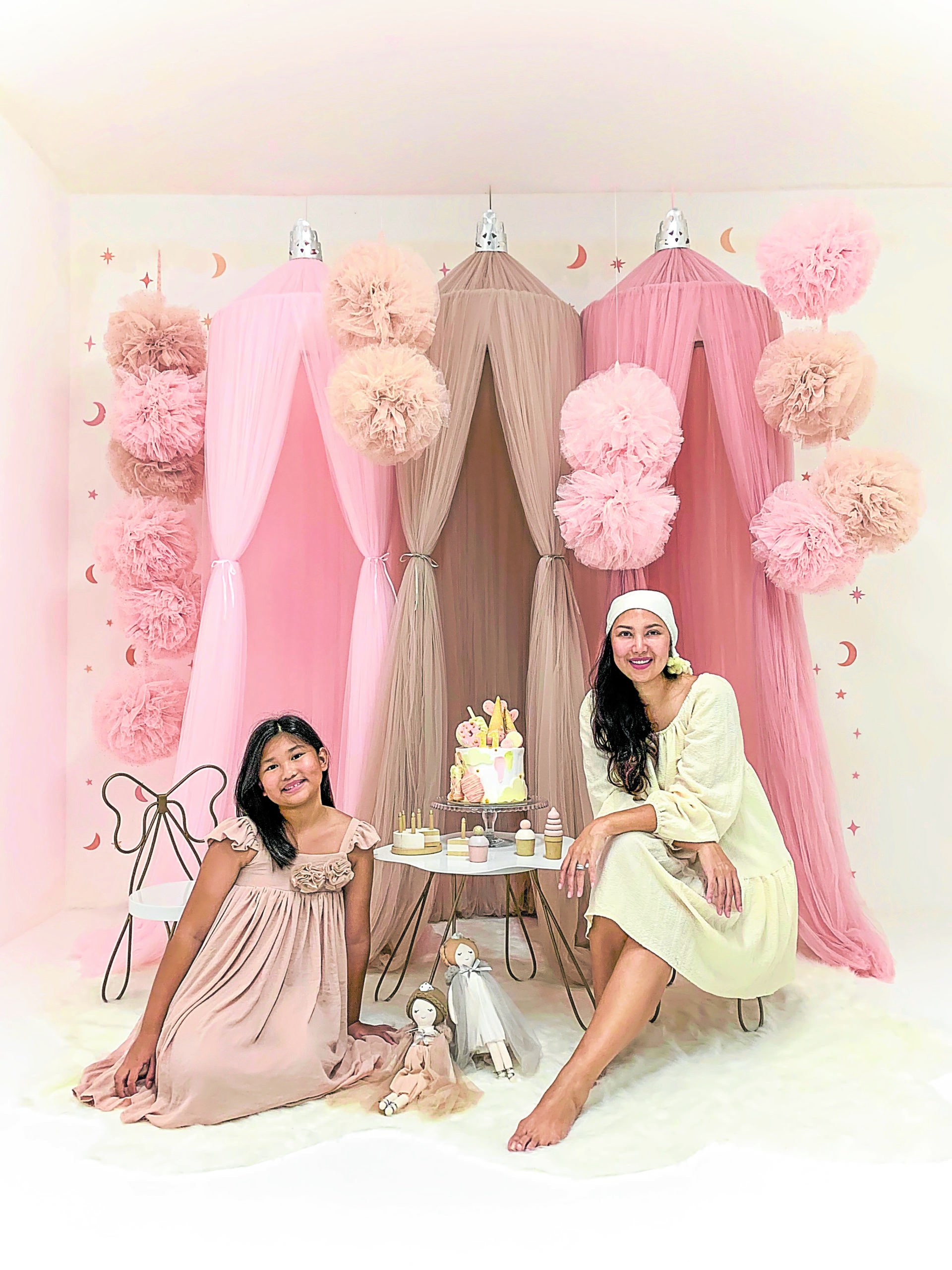
from Spinkiewear that matches the dream canopies and the pompom mobiles. The setup
includes the Butterfly Chair and Clip table and the soft dolls.
Surrounded by the canopy’s sheer white tulle, the bed becomes more inviting with a bow-shaped pillow, fluffy stuffed swans and a princess doll. The rest of the room decor is kept simple with a chair supported by butterfly wings and a matching white table with legs shaped like clips.
The snuggly setting is an Instagram post by Ceres, an American mother who decorated her daughter’s nursery using Spinkie’s products.
This lulling ambience is what Spinkie, a brand of home decor, soft toys and girl’s wear, is trying to evoke. Its look in all its e-commerce and social media post carries a Western aesthetic of soft, muted colors and a restrained decor style. People are surprised to learn that Spinkie is an online Filipino brand which is based in Alfonso, Cavite.
Despite the shipping delays due to lockdowns and episodes of Taal Volcano’s eruptions, Spinkie has been experiencing double-digit growth through increased efficiency and productivity. Former actress/beauty queen, “mompreneur” and Spinkie founder Mutya Laxa Buensuceso has been able to cope with the uncertainties that come with entrepreneurship and the pandemic while also ensuring that her children receive attention at home. The adversities have heightened Buensuceso’s empathy toward work-from-home (WFH) mothers, who have been going through similar challenges.

Star product
Spinkie started out with ergonomic butterfly pillows for infants in 2010 when Buensuceso was still working in Singapore. It was relaunched in 2016 with its now star product, the Dream Canopy.
“The canopy expanded our imagination to create a different, world—dreamy and happy,” Buensuceso says. “That is the magic we bring to different nurseries around the world and it’s caught on in the Philippines. We created teepees, sparkly swans, pompom chandeliers, princess dolls of different ethnicity and gender-neutral soft toys such as llamas.“
She adds, “In this pandemic, we are here to uplift their spirits.”
Two years ago, Buensuceso launched Spinkie Wear, froufrou dresses that matched the tulle canopies and the pompom decor. The top seller, Le Pompom, a frothy tulle dress with a pompom corsage on the yoke, became the preschooler’s favorite birthday dress in the Philippines.
Buensuceso attributes Spinkie’s success to its business ecosystem of WFH moms—50 sewers around National Capital Region, 77 international stockists who opened shops in their houses, online resellers in 34 countries and mothers/stylists/bloggers who post nursery vignettes using Spinkie’s products to boost the brand’s credibility. The sewers were grateful to be earning continuously at this difficult time. Most of the commissions go to the mothers who sell Spinkie’s products abroad.
“We have a warehouse network in different parts of the world who deal with customers in their countries,” says Buensuceso. The global market has made Spinkie one of DHL’s top Filipino accounts in overseas shipping.
She cites that Spinkie has been lucrative because of the clockwork precision in the business processes, teamwork, collaboration with content creators (the social media-savvy moms) and the daily grind of being online.
Buensuceso notes that every IG post in Spinkie’s social media is supported by an objective and a strategy, such as how to style its products in a real setting. “The content is backed up by insight and data,” she adds.

canopy, pompom garland, teepee and Swan Princess stuffed toy can create a gender-neutral
space for the boys.
Juggling act
Like mompreneurs, Buensuceso juggles between work and family. She manages to spend quality time with her kids while setting parameters for the business. The home basement has been converted into a professional office, which includes a station for e-commerce, a coworking space, a conference area set up like a living room, a professional photography studio and an area for virtual meetings. Spinkie’s warehouse was built behind their residence.
Spaces were reworked for the children’s remote learning. Mayumi’s study place is situated at the office while Malaya, 9, set up a working area in his bedroom.
“You can never be too busy for the children. Work from home allows me to manage my time with them. We have rules so that we can accomplish what we need to do. My kids know our work hours—my meetings are 10 a.m. to 12 noon and 1 to 3 p.m. That’s when they engage in school. We can huddle during break time,” explains Buensuceso.
Taking care of young kids has been, naturally, time-consuming. “The kids think they have access to you 24/7 because you are physically present. You have to remind them about office time,” she says.
“Still, when someone cries, I have to rush and ask why. Sometimes I have to attend 11 to 12 meetings a day, yet I run to the kitchen to make a quick lunch for the kids. They return to their school work afterward. Work-life balance is about finding the rhythm for both. You need to keep adjusting. Everything is a process. We must be happy with what we have attained today.” —CONTRIBUTED













































